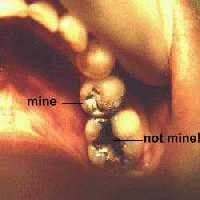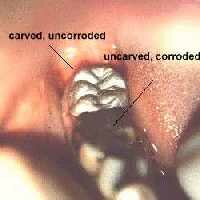
How Are Amalgams Placed?
Before your dentist places an amalgam, the tooth has to be properly prepared. The cavity has to be cleared of any decay or debris and the shape of the cavity has to conform to a shape that would effectively 'lock' an amalgam into the cavity. This is important as unless the amalgam is bonded (ie adhered or 'stuck') to the tooth with a special bonding agent, the only thing holding the amalgam is the shape of the cavity. Every cavity is prepared with 'undercuts' so that the base of the cavity is larger than the opening. This ensures that when an amalgam is placed into the cavity, it will lock into place once hardened. The amalgam on the right, on the premolar, is carved and uncorroded
 Once the cavity is prepared, your dentist will often line the cavity - this is so that the interior surface of the cavity is sealed. A common lining agent is varnish! At my practice, I commonly treat the tooth with a desensitizing agent and then use a bonding (adhesive) agent BEFORE placing the amalgam. This is thought to reduce the sensitivity that you sometimes get after a large metal filling is placed on your tooth. The tooth is then banded - eg surrounded with a metal band - to help packing and the amalgam is packed into the cavity under pressure. This helps force excess mercury out of the amalgam and ensures that the set amalgam is hard. After the cavity is well and truly filled, the excess amalgam is carved off the tooth.
Once the cavity is prepared, your dentist will often line the cavity - this is so that the interior surface of the cavity is sealed. A common lining agent is varnish! At my practice, I commonly treat the tooth with a desensitizing agent and then use a bonding (adhesive) agent BEFORE placing the amalgam. This is thought to reduce the sensitivity that you sometimes get after a large metal filling is placed on your tooth. The tooth is then banded - eg surrounded with a metal band - to help packing and the amalgam is packed into the cavity under pressure. This helps force excess mercury out of the amalgam and ensures that the set amalgam is hard. After the cavity is well and truly filled, the excess amalgam is carved off the tooth.
LINKS | TOPICS ONLINE | SEARCH | HOME